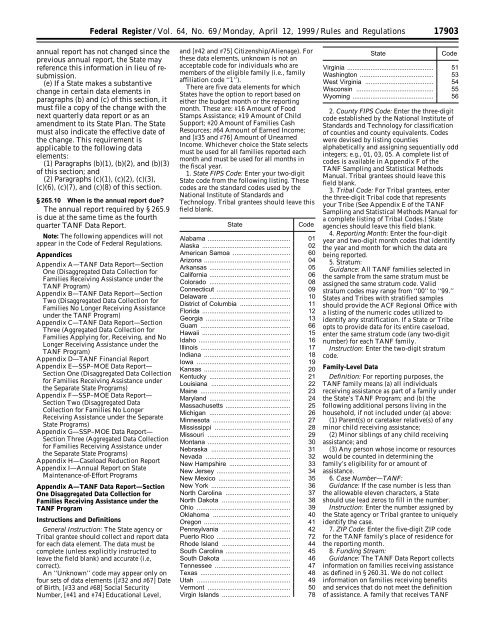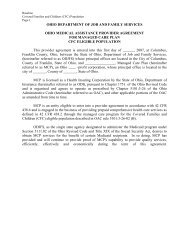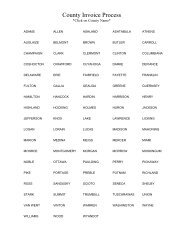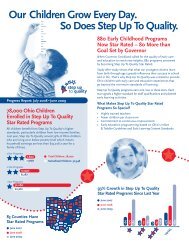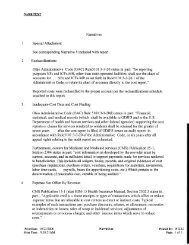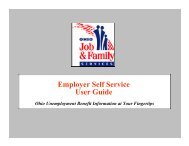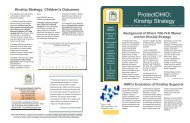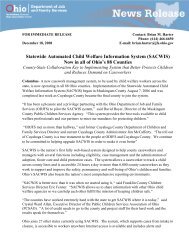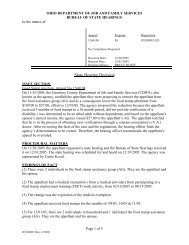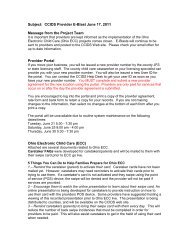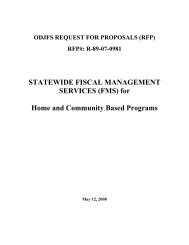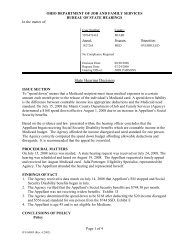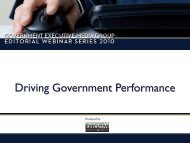Final TANF Rule as published in the Federal Register 4/12/1999
Final TANF Rule as published in the Federal Register 4/12/1999
Final TANF Rule as published in the Federal Register 4/12/1999
You also want an ePaper? Increase the reach of your titles
YUMPU automatically turns print PDFs into web optimized ePapers that Google loves.
<strong>Federal</strong> <strong>Register</strong> / Vol. 64, No. 69 / Monday, April <strong>12</strong>, <strong>1999</strong> / <strong>Rule</strong>s and Regulations<br />
annual report h<strong>as</strong> not changed s<strong>in</strong>ce <strong>the</strong><br />
previous annual report, <strong>the</strong> State may<br />
reference this <strong>in</strong>formation <strong>in</strong> lieu of resubmission.<br />
(e) If a State makes a substantive<br />
change <strong>in</strong> certa<strong>in</strong> data elements <strong>in</strong><br />
paragraphs (b) and (c) of this section, it<br />
must file a copy of <strong>the</strong> change with <strong>the</strong><br />
next quarterly data report or <strong>as</strong> an<br />
amendment to its State Plan. The State<br />
must also <strong>in</strong>dicate <strong>the</strong> effective date of<br />
<strong>the</strong> change. This requirement is<br />
applicable to <strong>the</strong> follow<strong>in</strong>g data<br />
elements:<br />
(1) Paragraphs (b)(1), (b)(2), and (b)(3)<br />
of this section; and<br />
(2) Paragraphs (c)(1), (c)(2), (c)(3),<br />
(c)(6), (c)(7), and (c)(8) of this section.<br />
§ 265.10 When is <strong>the</strong> annual report due?<br />
The annual report required by § 265.9<br />
is due at <strong>the</strong> same time <strong>as</strong> <strong>the</strong> fourth<br />
quarter <strong>TANF</strong> Data Report.<br />
Note: The follow<strong>in</strong>g appendices will not<br />
appear <strong>in</strong> <strong>the</strong> Code of <strong>Federal</strong> Regulations.<br />
Appendices<br />
Appendix A—<strong>TANF</strong> Data Report—Section<br />
One (Disaggregated Data Collection for<br />
Families Receiv<strong>in</strong>g Assistance under <strong>the</strong><br />
<strong>TANF</strong> Program)<br />
Appendix B—<strong>TANF</strong> Data Report—Section<br />
Two (Disaggregated Data Collection for<br />
Families No Longer Receiv<strong>in</strong>g Assistance<br />
under <strong>the</strong> <strong>TANF</strong> Program)<br />
Appendix C—<strong>TANF</strong> Data Report—Section<br />
Three (Aggregated Data Collection for<br />
Families Apply<strong>in</strong>g for, Receiv<strong>in</strong>g, and No<br />
Longer Receiv<strong>in</strong>g Assistance under <strong>the</strong><br />
<strong>TANF</strong> Program)<br />
Appendix D—<strong>TANF</strong> F<strong>in</strong>ancial Report<br />
Appendix E—SSP–MOE Data Report—<br />
Section One (Disaggregated Data Collection<br />
for Families Receiv<strong>in</strong>g Assistance under<br />
<strong>the</strong> Separate State Programs)<br />
Appendix F—SSP–MOE Data Report—<br />
Section Two (Disaggregated Data<br />
Collection for Families No Longer<br />
Receiv<strong>in</strong>g Assistance under <strong>the</strong> Separate<br />
State Programs)<br />
Appendix G—SSP–MOE Data Report—<br />
Section Three (Aggregated Data Collection<br />
for Families Receiv<strong>in</strong>g Assistance under<br />
<strong>the</strong> Separate State Programs)<br />
Appendix H—C<strong>as</strong>eload Reduction Report<br />
Appendix I—Annual Report on State<br />
Ma<strong>in</strong>tenance-of-Effort Programs<br />
Appendix A—<strong>TANF</strong> Data Report—Section<br />
One Disaggregated Data Collection for<br />
Families Receiv<strong>in</strong>g Assistance under <strong>the</strong><br />
<strong>TANF</strong> Program<br />
Instructions and Def<strong>in</strong>itions<br />
General Instruction: The State agency or<br />
Tribal grantee should collect and report data<br />
for each data element. The data must be<br />
complete (unless explicitly <strong>in</strong>structed to<br />
leave <strong>the</strong> field blank) and accurate (i.e,<br />
correct).<br />
An ‘‘Unknown’’ code may appear only on<br />
four sets of data elements ([#32 and #67] Date<br />
of Birth, [#33 and #68] Social Security<br />
Number, [#41 and #74] Educational Level,<br />
and [#42 and #75] Citizenship/Alienage). For<br />
<strong>the</strong>se data elements, unknown is not an<br />
acceptable code for <strong>in</strong>dividuals who are<br />
members of <strong>the</strong> eligible family (i.e., family<br />
affiliation code ‘‘1’’).<br />
There are five data elements for which<br />
States have <strong>the</strong> option to report b<strong>as</strong>ed on<br />
ei<strong>the</strong>r <strong>the</strong> budget month or <strong>the</strong> report<strong>in</strong>g<br />
month. These are: #16 Amount of Food<br />
Stamps Assistance; #19 Amount of Child<br />
Support; #20 Amount of Families C<strong>as</strong>h<br />
Resources; #64 Amount of Earned Income;<br />
and [#35 and #76] Amount of Unearned<br />
Income. Whichever choice <strong>the</strong> State selects<br />
must be used for all families reported each<br />
month and must be used for all months <strong>in</strong><br />
<strong>the</strong> fiscal year.<br />
1. State FIPS Code: Enter your two-digit<br />
State code from <strong>the</strong> follow<strong>in</strong>g list<strong>in</strong>g. These<br />
codes are <strong>the</strong> standard codes used by <strong>the</strong><br />
National Institute of Standards and<br />
Technology. Tribal grantees should leave this<br />
field blank.<br />
State Code<br />
Alabama .............................................. 01<br />
Al<strong>as</strong>ka ................................................. 02<br />
American Samoa ................................ 60<br />
Arizona ................................................ 04<br />
Arkans<strong>as</strong> ............................................. 05<br />
California ............................................. 06<br />
Colorado ............................................. 08<br />
Connecticut ......................................... 09<br />
Delaware ............................................. 10<br />
District of Columbia ............................ 11<br />
Florida ................................................. <strong>12</strong><br />
Georgia ............................................... 13<br />
Guam .................................................. 66<br />
Hawaii ................................................. 15<br />
Idaho ................................................... 16<br />
Ill<strong>in</strong>ois .................................................. 17<br />
Indiana ................................................ 18<br />
Iowa .................................................... 19<br />
Kans<strong>as</strong> ................................................ 20<br />
Kentucky ............................................. 21<br />
Louisiana ............................................ 22<br />
Ma<strong>in</strong>e .................................................. 23<br />
Maryland ............................................. 24<br />
M<strong>as</strong>sachusetts .................................... 25<br />
Michigan ............................................. 26<br />
M<strong>in</strong>nesota ........................................... 27<br />
Mississippi .......................................... 28<br />
Missouri .............................................. 29<br />
Montana .............................................. 30<br />
Nebr<strong>as</strong>ka ............................................ 31<br />
Nevada ............................................... 32<br />
New Hampshire .................................. 33<br />
New Jersey ......................................... 34<br />
New Mexico ........................................ 35<br />
New York ............................................ 36<br />
North Carol<strong>in</strong>a .................................... 37<br />
North Dakota ...................................... 38<br />
Ohio .................................................... 39<br />
Oklahoma ........................................... 40<br />
Oregon ................................................ 41<br />
Pennsylvania ...................................... 42<br />
Puerto Rico ......................................... 72<br />
Rhode Island ...................................... 44<br />
South Carol<strong>in</strong>a .................................... 45<br />
South Dakota ...................................... 46<br />
Tennessee .......................................... 47<br />
Tex<strong>as</strong> .................................................. 48<br />
Utah .................................................... 49<br />
Vermont .............................................. 50<br />
Virg<strong>in</strong> Islands ...................................... 78<br />
17903<br />
State Code<br />
Virg<strong>in</strong>ia ................................................ 51<br />
W<strong>as</strong>h<strong>in</strong>gton ......................................... 53<br />
West Virg<strong>in</strong>ia ...................................... 54<br />
Wiscons<strong>in</strong> ........................................... 55<br />
Wyom<strong>in</strong>g ............................................. 56<br />
2. County FIPS Code: Enter <strong>the</strong> three-digit<br />
code established by <strong>the</strong> National Institute of<br />
Standards and Technology for cl<strong>as</strong>sification<br />
of counties and county equivalents. Codes<br />
were devised by list<strong>in</strong>g counties<br />
alphabetically and <strong>as</strong>sign<strong>in</strong>g sequentially odd<br />
<strong>in</strong>tegers; e.g., 01, 03, 05. A complete list of<br />
codes is available <strong>in</strong> Appendix F of <strong>the</strong><br />
<strong>TANF</strong> Sampl<strong>in</strong>g and Statistical Methods<br />
Manual. Tribal grantees should leave this<br />
field blank.<br />
3. Tribal Code: For Tribal grantees, enter<br />
<strong>the</strong> three-digit Tribal code that represents<br />
your Tribe (See Appendix E of <strong>the</strong> <strong>TANF</strong><br />
Sampl<strong>in</strong>g and Statistical Methods Manual for<br />
a complete list<strong>in</strong>g of Tribal Codes.) State<br />
agencies should leave this field blank.<br />
4. Report<strong>in</strong>g Month: Enter <strong>the</strong> four-digit<br />
year and two-digit month codes that identify<br />
<strong>the</strong> year and month for which <strong>the</strong> data are<br />
be<strong>in</strong>g reported.<br />
5. Stratum:<br />
Guidance: All <strong>TANF</strong> families selected <strong>in</strong><br />
<strong>the</strong> sample from <strong>the</strong> same stratum must be<br />
<strong>as</strong>signed <strong>the</strong> same stratum code. Valid<br />
stratum codes may range from ‘‘00’’ to ‘‘99.’’<br />
States and Tribes with stratified samples<br />
should provide <strong>the</strong> ACF Regional Office with<br />
a list<strong>in</strong>g of <strong>the</strong> numeric codes utilized to<br />
identify any stratification. If a State or Tribe<br />
opts to provide data for its entire c<strong>as</strong>eload,<br />
enter <strong>the</strong> same stratum code (any two-digit<br />
number) for each <strong>TANF</strong> family.<br />
Instruction: Enter <strong>the</strong> two-digit stratum<br />
code.<br />
Family-Level Data<br />
Def<strong>in</strong>ition: For report<strong>in</strong>g purposes, <strong>the</strong><br />
<strong>TANF</strong> family means (a) all <strong>in</strong>dividuals<br />
receiv<strong>in</strong>g <strong>as</strong>sistance <strong>as</strong> part of a family under<br />
<strong>the</strong> State’s <strong>TANF</strong> Program; and (b) <strong>the</strong><br />
follow<strong>in</strong>g additional persons liv<strong>in</strong>g <strong>in</strong> <strong>the</strong><br />
household, if not <strong>in</strong>cluded under (a) above:<br />
(1) Parent(s) or caretaker relative(s) of any<br />
m<strong>in</strong>or child receiv<strong>in</strong>g <strong>as</strong>sistance;<br />
(2) M<strong>in</strong>or sibl<strong>in</strong>gs of any child receiv<strong>in</strong>g<br />
<strong>as</strong>sistance; and<br />
(3) Any person whose <strong>in</strong>come or resources<br />
would be counted <strong>in</strong> determ<strong>in</strong><strong>in</strong>g <strong>the</strong><br />
family’s eligibility for or amount of<br />
<strong>as</strong>sistance.<br />
6. C<strong>as</strong>e Number—<strong>TANF</strong>:<br />
Guidance: If <strong>the</strong> c<strong>as</strong>e number is less than<br />
<strong>the</strong> allowable eleven characters, a State<br />
should use lead zeros to fill <strong>in</strong> <strong>the</strong> number.<br />
Instruction: Enter <strong>the</strong> number <strong>as</strong>signed by<br />
<strong>the</strong> State agency or Tribal grantee to uniquely<br />
identify <strong>the</strong> c<strong>as</strong>e.<br />
7. ZIP Code: Enter <strong>the</strong> five-digit ZIP code<br />
for <strong>the</strong> <strong>TANF</strong> family’s place of residence for<br />
<strong>the</strong> report<strong>in</strong>g month.<br />
8. Fund<strong>in</strong>g Stream:<br />
Guidance: The <strong>TANF</strong> Data Report collects<br />
<strong>in</strong>formation on families receiv<strong>in</strong>g <strong>as</strong>sistance<br />
<strong>as</strong> def<strong>in</strong>ed <strong>in</strong> § 260.31. We do not collect<br />
<strong>in</strong>formation on families receiv<strong>in</strong>g benefits<br />
and services that do not meet <strong>the</strong> def<strong>in</strong>ition<br />
of <strong>as</strong>sistance. A family that receives <strong>TANF</strong>


